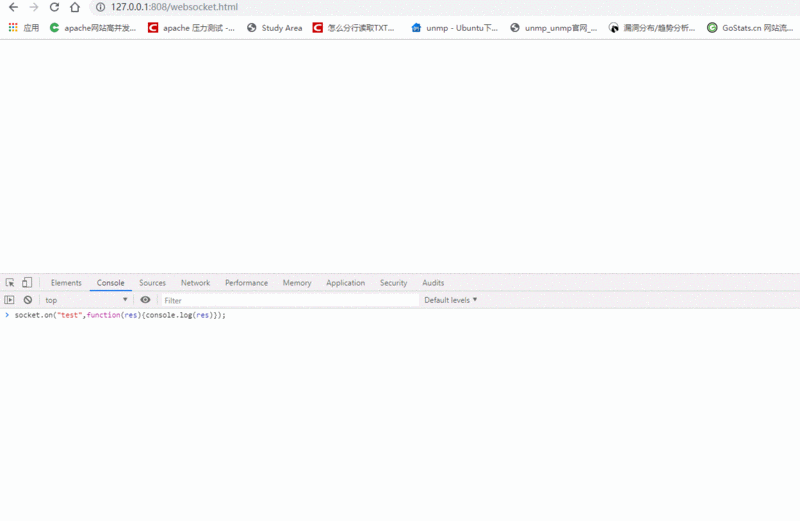thinkphp 6.0 swoole擴充websocket的使用
- 藏色散人轉載
- 2020-12-15 09:35:533030瀏覽
下面由thinkphp框架教學專欄跟大家介紹thinkphp 6.0 swoole擴充websocket使用教學(think-swoole),希望對需要的朋友有幫助!
thinkphp 6.0 swoole擴充websocket使用教學(think-swoole)
前言
最新版本的TP-SWOOLE變化很大,該文所提供的方法已經無法使用,可參考https://github.com/xavieryang007/think-swoole-demo/blob/master/doc/文件/4.1-websocket.md
介紹
即將推出的tp6.0,已經適配swoole.並推出think-swoole 3.0,並且預設適配了socketio。和2.0版本在使用方法上面有些許不同。
Websocket 繼承與Http,進行websocket連線之前需要一次HTTP請求,如果當期位址支援websocket則回傳101,然後進行連線。也就是說不是我的服務支援websocket後,請求每個連接位址都可以進行websocket連接,而是需要預先適配才可以連接。
參數配置
如果要使用websocket需要在設定中啟用,將websocket下的enable設定為true
'server' => [
'host' => '0.0.0.0', // 监听地址
'port' => 808, // 监听端口
'mode' => SWOOLE_PROCESS, // 运行模式 默认为SWOOLE_PROCESS
'sock_type' => SWOOLE_SOCK_TCP, // sock type 默认为SWOOLE_SOCK_TCP
'options' => [
'pid_file' => runtime_path() . 'swoole.pid',
'log_file' => runtime_path() . 'swoole.log',
'daemonize' => false,
// Normally this value should be 1~4 times larger according to your cpu cores.
'reactor_num' => swoole_cpu_num(),
'worker_num' => swoole_cpu_num(),
'task_worker_num' => 4,//swoole_cpu_num(),
'enable_static_handler' => true,
'document_root' => root_path('public'),
'package_max_length' => 20 * 1024 * 1024,
'buffer_output_size' => 10 * 1024 * 1024,
'socket_buffer_size' => 128 * 1024 * 1024,
'max_request' => 3000,
'send_yield' => true,
],
],
'websocket' => [
'enabled' => true,// 开启websocket
'handler' => Handler::class, //自定义wbesocket绑定类
'parser' => Parser::class, //自定义解析类
'route_file' => base_path() . 'websocket.php',
'ping_interval' => 25000,
'ping_timeout' => 60000,
'room' => [
'type' => TableRoom::class,
'room_rows' => 4096,
'room_size' => 2048,
'client_rows' => 8192,
'client_size' => 2048,
],
],
'auto_reload' => true,
'enable_coroutine' => true,
'resetters' => [],
'tables' => [],
handler和parser大大方便了自訂websocket服務,預設系統整合socketio。
本文主要介紹如何使用socketio,這裡假設大家有socketio有一定了解和使用基礎。
socketIo預設會在請求位址後加上對應的參數

同時,socketio預設會在請求位址後加上對應的參數

同時,socketio預設會在請求位址後加上對應的參數
同時,socketio預設情況下,會認為 http://url/socket.io / 是支援websocket服務的地址。而在tp-swoole3.0內部已經對該位址請求進行了處理
<?php namespace think\swoole\websocket\socketio;
use think\Config;
use think\Cookie;
use think\Request;
class Controller
{
protected $transports = ['polling', 'websocket'];
public function upgrade(Request $request, Config $config, Cookie $cookie)
{
if (!in_array($request->param('transport'), $this->transports)) {
return json(
[
'code' => 0,
'message' => 'Transport unknown',
],
400
);
}
if ($request->has('sid')) {
$response = response('1:6');
} else {
$sid = base64_encode(uniqid());
$payload = json_encode(
[
'sid' => $sid,
'upgrades' => ['websocket'],
'pingInterval' => $config->get('swoole.websocket.ping_interval'),
'pingTimeout' => $config->get('swoole.websocket.ping_timeout'),
]
);
$cookie->set('io', $sid);
$response = response('97:0' . $payload . '2:40');
}
return $response->contentType('text/plain');
}
public function reject(Request $request)
{
return json(
[
'code' => 3,
'message' => 'Bad request',
],
400
);
}
}TP6.0,插件註冊採用了service方式進行了註冊,可在tp-swoole 服務註冊文件中查看路由註冊資訊,如果想自訂連結規則,則可以覆蓋該路由。
<?php // +----------------------------------------------------------------------
// | ThinkPHP [ WE CAN DO IT JUST THINK IT ]
// +----------------------------------------------------------------------
// | Copyright (c) 2006-2018 http://thinkphp.cn All rights reserved.
// +----------------------------------------------------------------------
// | Licensed ( http://www.apache.org/licenses/LICENSE-2.0 )
// +----------------------------------------------------------------------
// | Author: yunwuxin <448901948@qq.com>
// +----------------------------------------------------------------------
namespace think\swoole;
use Swoole\Http\Server as HttpServer;
use Swoole\Websocket\Server as WebsocketServer;
use think\App;
use think\Route;
use think\swoole\command\Server as ServerCommand;
use think\swoole\facade\Server;
use think\swoole\websocket\socketio\Controller;
use think\swoole\websocket\socketio\Middleware;
class Service extends \think\Service
{
protected $isWebsocket = false;
/**
* @var HttpServer | WebsocketServer
*/
protected static $server;
public function register()
{
$this->isWebsocket = $this->app->config->get('swoole.websocket.enabled', false);
$this->app->bind(Server::class, function () {
if (is_null(static::$server)) {
$this->createSwooleServer();
}
return static::$server;
});
$this->app->bind('swoole.server', Server::class);
$this->app->bind(Swoole::class, function (App $app) {
return new Swoole($app);
});
$this->app->bind('swoole', Swoole::class);
}
public function boot(Route $route)
{
$this->commands(ServerCommand::class);
if ($this->isWebsocket) {
$route->group(function () use ($route) {
$route->get('socket.io/', '@upgrade');
$route->post('socket.io/', '@reject');
})->prefix(Controller::class)->middleware(Middleware::class);
}
}
/**
* Create swoole server.
*/
protected function createSwooleServer()
{
$server = $this->isWebsocket ? WebsocketServer::class : HttpServer::class;
$config = $this->app->config;
$host = $config->get('swoole.server.host');
$port = $config->get('swoole.server.port');
$socketType = $config->get('swoole.server.socket_type', SWOOLE_SOCK_TCP);
$mode = $config->get('swoole.server.mode', SWOOLE_PROCESS);
static::$server = new $server($host, $port, $mode, $socketType);
$options = $config->get('swoole.server.options');
static::$server->set($options);
}
}
Socketio預設使用demo
nbsp;html>
<meta>
<title>Title</title>
<script></script>
<script>
const socket = io('http://localhost:808');
socket.emit("test", "your message");
socket.on("test",function(res){console.log(res)});
</script>
###Websocket路由設定方法######在app目錄下新建websocket.php檔案,其中需要注意,由於使用了反射,閉包參數名稱不能隨意定義,不然無法注入。第一個參數是websocket,是目前websocket的Server對象,第二個參數data是客戶端發送的資料。其中socketio emit的第一個參數和Websocket::on的第一個參數一致,作為事件名稱。 ###<?php /**
* Author:Xavier Yang
* Date:2019/6/5
* Email:499873958@qq.com
*/
use \think\swoole\facade\Websocket;
Websocket::on("test", function (\think\swoole\Websocket $websocket, $data) {
//var_dump($class);
$websocket->emit("test", "asd");
});
Websocket::on("test1", function ($websocket, $data) {
$websocket->emit("test", "asd");
});
Websocket::on("join", function (\think\swoole\Websocket $websocket, $data) {
$websocket->join("1");
});############參考如上方法即可使用全新的websocket服務。當然tp-swoole3.0同樣還有許多其他的新功能,這些功能需要大家去摸索嘗試。 ###我也會在接下來的文章中,一起與大家分享我的使用流程。 ###以上是thinkphp 6.0 swoole擴充websocket的使用的詳細內容。更多資訊請關注PHP中文網其他相關文章!

